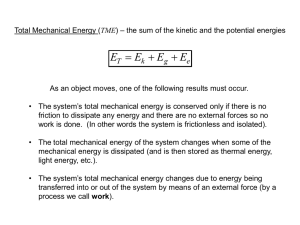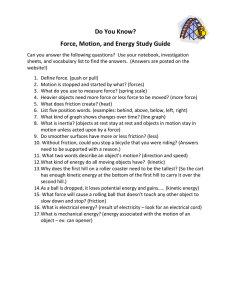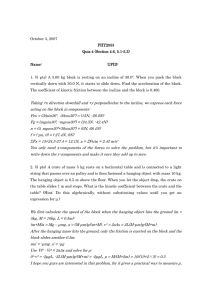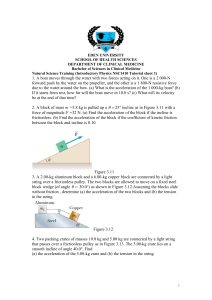Work, Kinetic Energy, Potential Energy, Energy Conservation File
advertisement
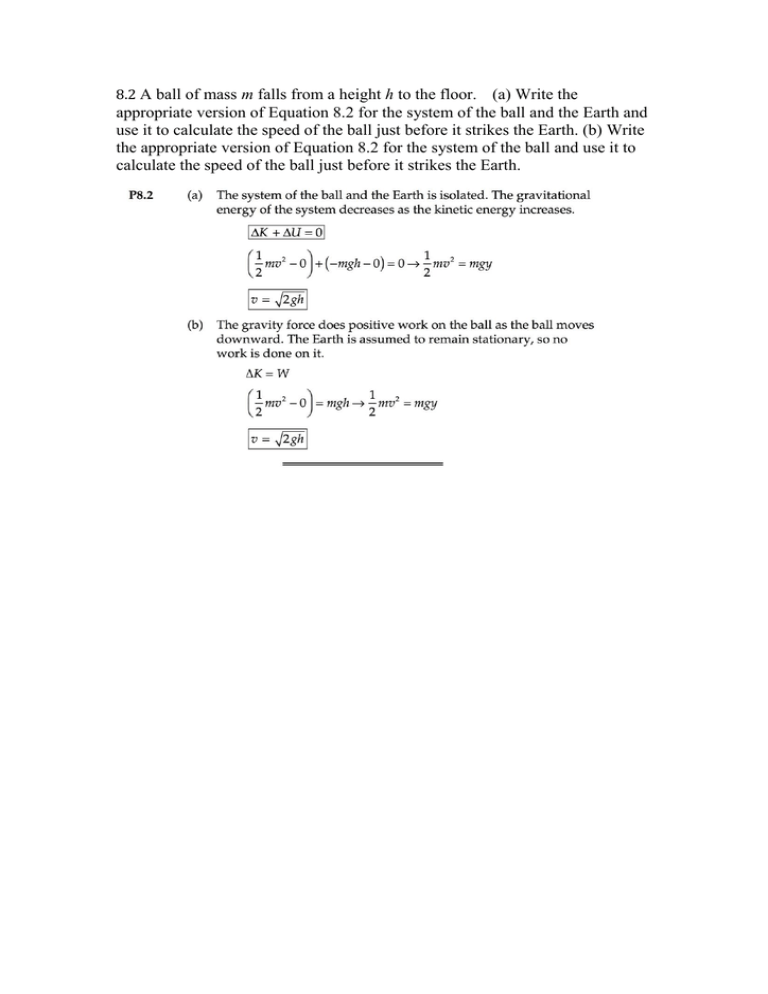
8.2 A ball of mass m falls from a height h to the floor. S (a) Write the appropriate version of Equation 8.2 for the system of the ball and the Earth and use it to calculate the speed of the ball just before it strikes the Earth. (b) Write the appropriate version of Equation 8.2 for the system of the ball and use it to calculate the speed of the ball just before it strikes the Earth. 8.5 A bead slides without friction around a loop-the-loop (Fig. P8.5). The bead is released from rest at a height h = 3.50R. (a) What is its speed at point A? (b) How large is the normal force on the bead at point A if its mass is 5.00 g? 8.6 A block of mass m = 5.00 kg is released from point A and slides on the frictionless track shown in Figure P8.6. Determine (a) the block’s speed at points B and C and (b) the net work done by the gravitational force on the block as it moves from point A to point C. 8.7 Two objects are connected by a light string passing over a light, frictionless pulley as shown in Figure P8.7. The object of mass m1 = 5.00 kg is released from rest at a height h = 4.00 m above the table. Using the isolated sys- tem model, (a) determine the speed of the object of mass m2 = 3.00 kg just as the 5.00-kg object hits the table and (b) find the maximum height above the table to which the 3.00-kg object rises. 8.14 A crate of mass 10.0 kg is pulled up a rough incline with an initial speed of 1.50 m/s. The pulling force is 100 N parallel to the incline, which makes an angle of 20.08 with the horizontal. The coefficient of kinetic friction is 0.400, and the crate is pulled 5.00 m. (a) How much work is done by the gravitational force on the crate? (b) Determine the increase in internal energy of the crate– incline system owing to friction. (c) How much work is done by the 100-N force on the crate? (d) What is the change in kinetic energy of the crate? (e) What is the speed of the crate after being pulled 5.00 m? 8.15 A block of mass m = 2.00 kg is attached to a spring of force constant k = 500 N/m as shown in Figure P8.15. The block is pulled to a posi tion xi = 5.00 cm to the right of equilibrium and released from rest. Find the speed the block has as it passes through equilibrium if (a) the horizontal surface is frictionless and (b) the coefficient of friction between block and surface is mk = 0.350. 8.25 A 200-g block is pressed against a spring of force constant 1.40 kN/m until the block compresses the spring 10.0 cm. The spring rests at the bottom of a ramp inclined at 60.08 to the horizontal. Using energy considerations, determine how far up the incline the block moves from its initial position before it stops (a) if the ramp exerts no friction force on the block and (b) if the coefficient of kinetic friction is 0.400. 8.27 A child of mass m starts from rest and slides without friction from a height h along a slide next to a pool (Fig. P8.27). She is launched from a height h/5 into the air over the pool. We wish to find the maximum height she reaches above the water in her projectile motion. (a) Is the child–Earth system isolated or nonisolated? Why? (b) Is there a nonconservative force acting within the system? (c) Define the configuration of the system when the child is at the water level as having zero gravitational potential energy. Express the total energy of the system when the child is at the top of the waterslide. (d) Express the total energy of the system when the child is at the launching point. (e) Express the total energy of the system when the child is at the highest point in her projectile motion. (f) From parts (c) and (d), determine her initial speed vi at the launch point in terms of g and h. (g) From parts (d), (e), and (f), determine her maximum airborne height ymax in terms of h and the launch angle u. (h) Would your answers be the same if the waterslide were not frictionless? Explain. 8.29 An 820-N Marine in basic training climbs a 12.0-m vertical rope at a constant speed in 8.00 s. What is his power output? 8.40 A 650-kg elevator starts from rest. It moves upward for 3.00 s with constant acceleration until it reaches its cruising speed of 1.75 m/s. (a) What is the average power of the elevator motor during this time interval? (b) How does this power compare with the motor power when the elevator moves at its cruising speed? 8.37 A 3.50-kN piano is lifted by three workers at constant speed to an apartment 25.0 m above the street using a pulley system fastened to the roof of the building. Each worker is able to deliver 165 W of power, and the pulley system is 75.0% efficient (so that 25.0% of the mechan- ical energy is transformed to other forms due to fric- tion in the pulley). Neglecting the mass of the pulley, find the time required to lift the piano from the street to the apartment. 8.49 As the driver steps on the gas pedal, a car of mass 1160 kg accelerates from rest. During the first few sec- onds of motion, the car’s acceleration increases with time according to the expression a=1.16 t- 0.210t2 + 0.240t3 where t is in seconds and a is in m/s2. (a) What is the change in kinetic energy of the car during the interval from t 5 0 to t 5 2.50 s? (b) What is the minimum aver- age power output of the engine over this time interval? (c) Why is the value in part (b) described as the minimum value? 8.63 A 10.0-kg block is released from rest at point A in Figure P8.63. The track is frictionless except for the portion between points B and C, which has a length of 6.00 m. The block travels down the track, hits a spring of force constant 2 250 N/m, and compresses the spring 0.300 m from its equilibrium position before coming to rest momentarily. Determine the coefficient of kinetic friction between the block and the rough surface between points B and C.
